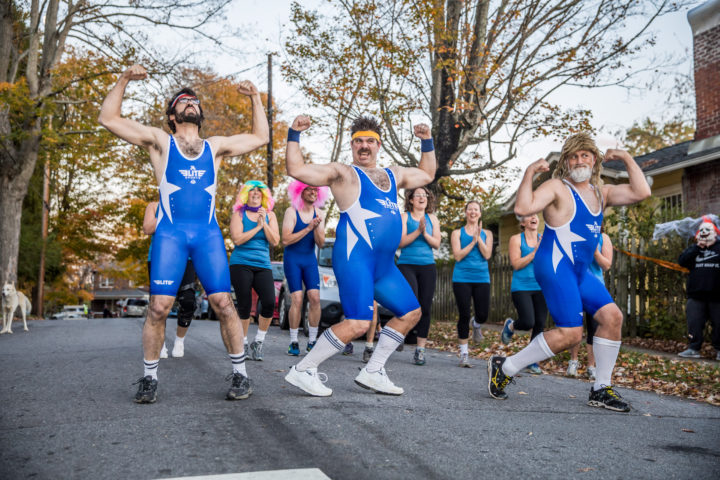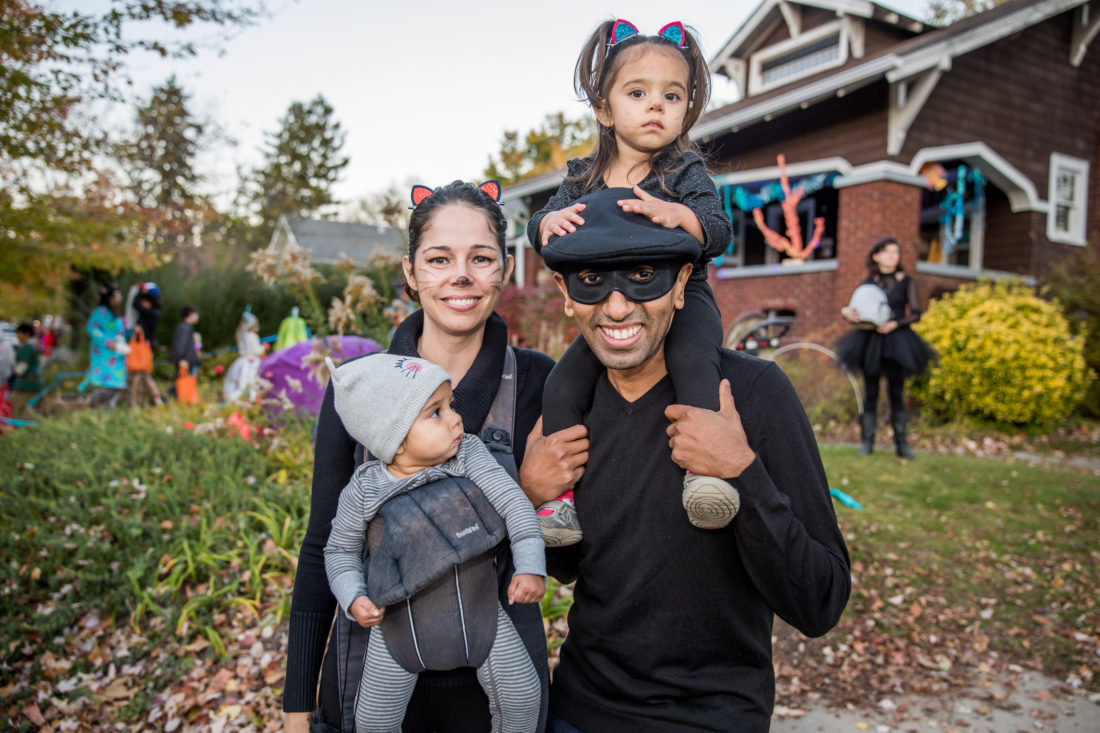When Emily and Adam McDaniel purchased their home on Vermont Avenue in West Asheville in September 2014, they were unaware of the ghosts, goblins and Star Wars stormtroopers that haunted the neighborhood. It was only as they closed on their house that their real estate agent remarked, almost as an afterthought, “Oh, and another thing — you’re on an amazing street for Halloween.”
Jon Derry has a similar story, except his predates the McDaniels’ by 15 years. In 1999, shortly after moving to Vermont Avenue, “I told somebody where I lived and they said, ‘Oh, trick-or-treat street,” he recalls. Derry doesn’t know when the avenue became the destination for costumed revelers in West Asheville. But he has noticed an increase in turnout over the last few years.
Fellow resident (and Xpress freelance writer) Cathy Cleary has her own theories on the area’s growing popularity. The avenue’s relatively flat surface and the proximity of its homes have always appealed to trick-or-treaters, she says. Yet it wasn’t until the road was closed to traffic that the numbers spiked from the hundreds to the more than 2,000 visitors that it currently attracts.
The barricades came about in 2012, courtesy of West Asheville community members Karen Ostergaard and Emily Bidwell. (Ostergaard has called Vermont Avenue home since 2004; Bidwell has lived in the general area for the last 17 years.) “We just try to manage the situation and make it safer for trick-or-treaters,” Ostergaard explains.
As the event continues to lure more families down the popular avenue, however, the organizers have seen a rise in associated costs. Online fundraisers, candy donations and volunteer services have all helped mitigate some of the expenses. But a hike in this year’s city permit fee has created a new hurdle for Ostergaard and Bidwell to clear, pushing them to the brink of exhaustion.
“I don’t want to see trick-or-treaters and cars sharing the street,” Ostergaard says. “It would be great if there was some way the city could work with us.”
A numbers game
In previous years, the city’s temporary use permit, which is required to shut down Vermont Avenue, cost Ostergaard and Bidwell $100. This year, the price jumped to $500.
Jon Fillman, outdoor event manager for the city of Asheville, explains that the increase was included in the fiscal year 2018-19 fees and charges approved by City Council on April 10. Prior to the 2018 fiscal year, costs associated with the temporary use permit were determined by the number of structural items (such as tents) featured at an event. Because Halloween on Vermont Avenue does not include such a setup, its previous fees had been relatively low.
The new policy, however, determines cost by event attendance. Rates start at $100 for 49-100 people and climb as high as $500 for 1,000 people or more. With over 2,000 visitors at last year’s event and similar numbers expected at this year’s celebration, dues for Halloween on Vermont Avenue were increased to the maximum rate.
The cost, Fillman continues, covers building, fire and zoning reviews. The money also allows inspectors to attend the gathering to ensure proper safety measures are in place. “The bigger a project that you build, the more complex and detailed and costly it becomes,” he explains.
Cost-saving options are available, Fillman notes. “The city of Asheville most certainly works toward strategically connecting resources, services and programs to achieve the community’s vision and goals,” he states. Special event fee discounts and event partnerships are available.
However, to qualify for these programs, an organization must be a state or federally recognized nonprofit, which prevents Ostergaard and Bidwell from applying.
Strength of community
To offset some of the cost, the two organizers have teamed with Cascade Lounge owner and West Asheville resident Jolene Fleischbein, who will sponsor one of the event’s seven barricades at a cost of $235.

It’s not the first time local businesses have stepped in to help, Bidwell points out. Sunny Point Café, The Brew Pump, Biscuit Head and West Village Market & Deli have all contributed to the event by gathering and storing candy prior to Halloween. (On the day of, Bidwell and Ostergaard distribute these goods to those in the neighborhood who request the service.)
A sponsored barricade, however, is new territory. Fleischbein, along with members of Cascade Lounge’s staff, will decorate their barrier with a disco ball and other accessories. Throughout the evening, they will also hand out free stickers and candy.
“I believe in the strength of community and live by the principle that you get what you put out in this world,” says Fleischbein. “If donating some money helps so that this event could cover the cost of the new permitting requirements, that’s a no-brainer.”
New perspective
Carrie Coffey is relatively new to Vermont Avenue. Two years ago, she relocated to the neighborhood by way of Los Angeles. While out west, she says, “I probably had eight trick-or-treaters in 10 years total. And five of them were my daughter and her friends.”
As is the case for many newcomers, Coffey quickly learned about the street’s annual festival. She says last year’s introduction exceeded all expectations. Homes lit up with decorations. Scary music blared. A neighbor, dressed in a gorilla costume, set up shop in a nearby tree and swung from its branches (terrifying some in the process while delighting others).
Meanwhile, a flash mob of witches erupted into a choreographed dance in the middle of the avenue as swarms of trick-or-treaters approached Coffey’s lawn. “At first, I let the kids pick and choose their treats,” she remembers. “But then I realized it wasn’t going to work that way, because there was this huge line forming.”
Like all rookies, and some seasoned veterans, Coffey eventually ran out of candy. But in the spirit and practice of Halloween on Vermont Avenue, neighbors came to the rescue, replenishing her supply.
In Coffey’s view, the solution to the increased permit fee is simple. “The city should waive the cost,” she says, stating that Ostergaard and Bidwell are performing a beloved and much-needed community service. Fillman says such an adjustment would require a vote by Council.
“It’s pretty special,” Coffey explains. “Especially with everything that is going on in the world.” The street closure, she says, creates a safe environment where kids — and some adults — can be kids. “It’s like a big, very positive and uplifting party,” she continues. “And you know, we need more of that these days.”






Our mayor, city council, and county council are useless obstacles to the citizens of our city. Time for some productive, positive change……
What the hell does that have to do with Halloween?
As history clearly shows , when you have democrackkks always running the show here, since forever, there will never be any productive positive change. As long as they keep segregating the poor into government plantations in Asheville, there can be no free people here, only unhappy people and growing CRIME. HACA is our biggest problem, and WE could change that.
It’s time to let this go. The concentration of people without permitting and protection is actually making it an unsafe place to be
LOL why yes, let’s ban trick or treating to while we’re at it. They bother no one nor does closing the street down cause traffic back ups. Maybe it’s time for people to wake up and realize that fee after fee after fee that the city is coming up with is a farce.